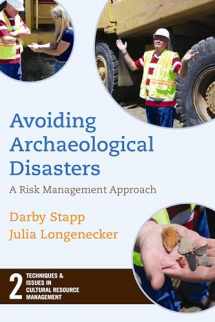
Avoiding Archaeological Disasters: Risk Management for Heritage Professionals (Techniques & Issues in Cultural Resource Management)
ISBN-13:
9781598741605
ISBN-10:
1598741608
Edition:
1
Author:
Darby C. Stapp, Julia Longenecker
Publication date:
2009
Publisher:
Routledge
Format:
Hardcover
176 pages
FREE US shipping
Book details
ISBN-13:
9781598741605
ISBN-10:
1598741608
Edition:
1
Author:
Darby C. Stapp, Julia Longenecker
Publication date:
2009
Publisher:
Routledge
Format:
Hardcover
176 pages
Summary
Avoiding Archaeological Disasters: Risk Management for Heritage Professionals (Techniques & Issues in Cultural Resource Management) (ISBN-13: 9781598741605 and ISBN-10: 1598741608), written by authors
Darby C. Stapp, Julia Longenecker, was published by Routledge in 2009.
With an overall rating of 3.9 stars, it's a notable title among other
books. You can easily purchase or rent Avoiding Archaeological Disasters: Risk Management for Heritage Professionals (Techniques & Issues in Cultural Resource Management) (Hardcover) from BooksRun,
along with many other new and used
books
and textbooks.
And, if you're looking to sell your copy, our current buyback offer is $0.3.
Description
You think it can’t happen to you, but it can. One day, months into your construction project, your front end load operator runs into bones and wooden slats. Your county coroner says it is not a crime scene, and refers you to the local archaeology department. The archaeologist tells you that it is a very important discovery. Work stops. Archaeological discoveries happen all the time in the course of projects. Most are manageable, some are less so, and some are mismanaged, wasting time and money. If you are not prepared, the consequences can be disastrous. This book is for project engineers, project managers, construction managers, the staff of affected government agencies, and archaeological consultants. In its pages you receive enough information, enough archaeological perspective, to intelligently work with the various parties involved in your project and avoid an archaeological disaster.


We would LOVE it if you could help us and other readers by reviewing the book
Book review

Congratulations! We have received your book review.
{user}
{createdAt}
by {truncated_author}


